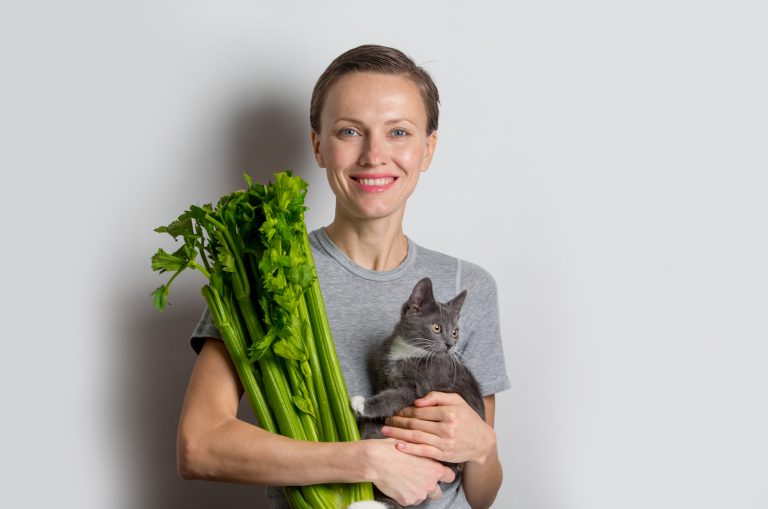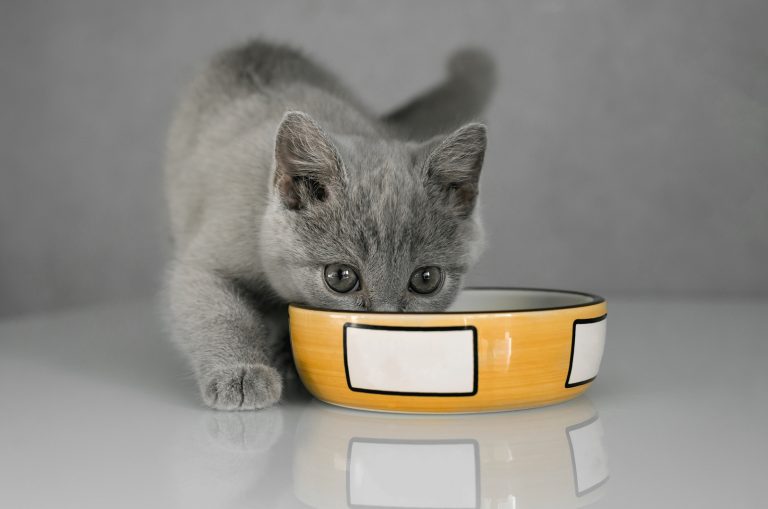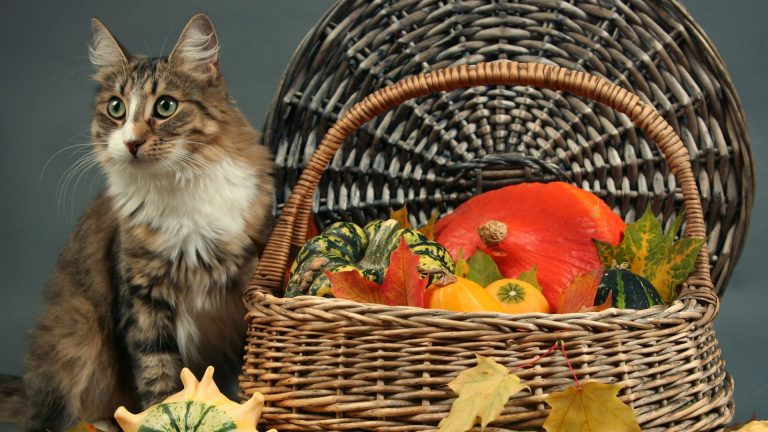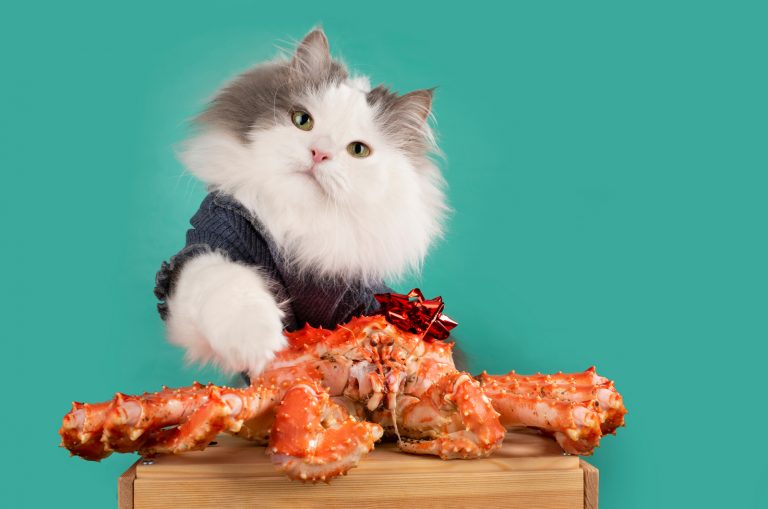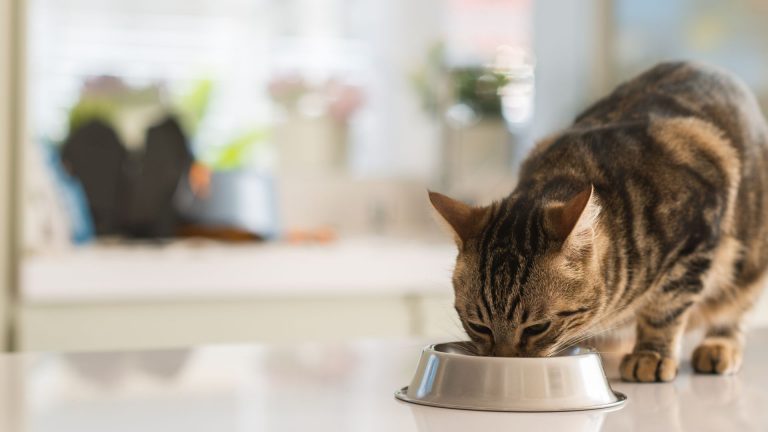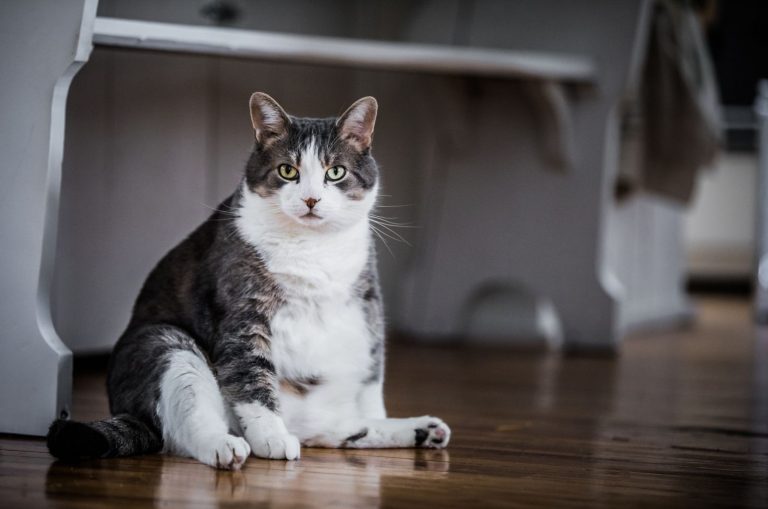Can Cats Eat Lettuce? Is It Safe Or Not?
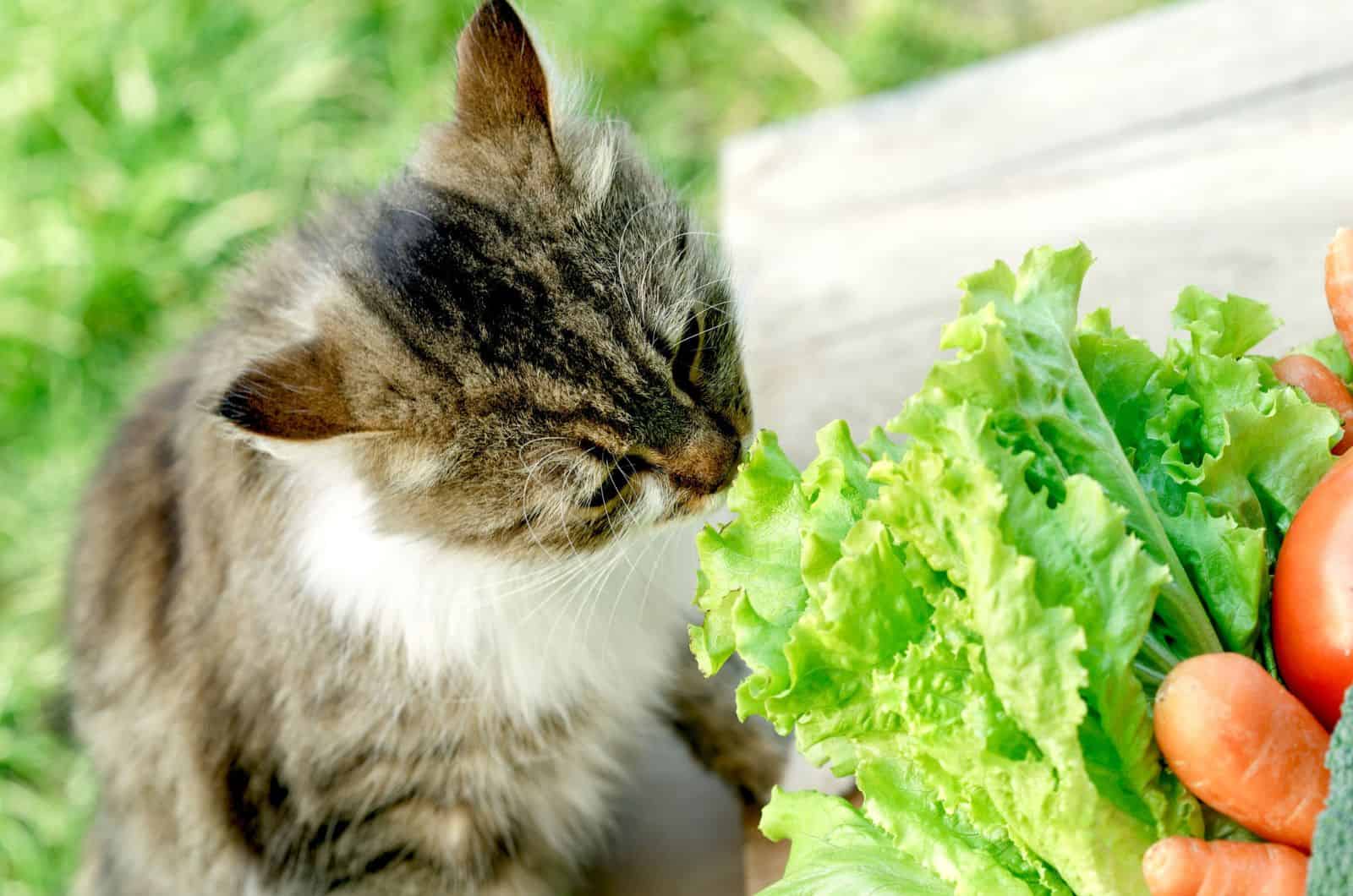
At some point, every cat owner wonders which human food they can safely feed to their cats. We all know that they can be quite persistent when asking for a taste of our food! Can a cat eat what you are eating? You’ve probably arrived here because you’ve got some juicy lettuce and you want to share it with your cat, but can cats eat lettuce? Is it safe if your furry friend nibbles on a leaf of lettuce?
In a word, yes. Lettuce is not toxic or poisonous for cats, so therefore you can feed lettuce to your cat. When making any major changes to your cat’s diet, you should do it gradually and if you have any concerns or need tailored dietary advice for your pet, consult your vet.
Continue reading to find out more about the question: can cats eat lettuce, what are its health benefits, how to safely feed lettuce to cats, and if there any health precautions or concerns that you should be aware of.
Can Cats Eat Lettuce? Benefits Of Lettuce
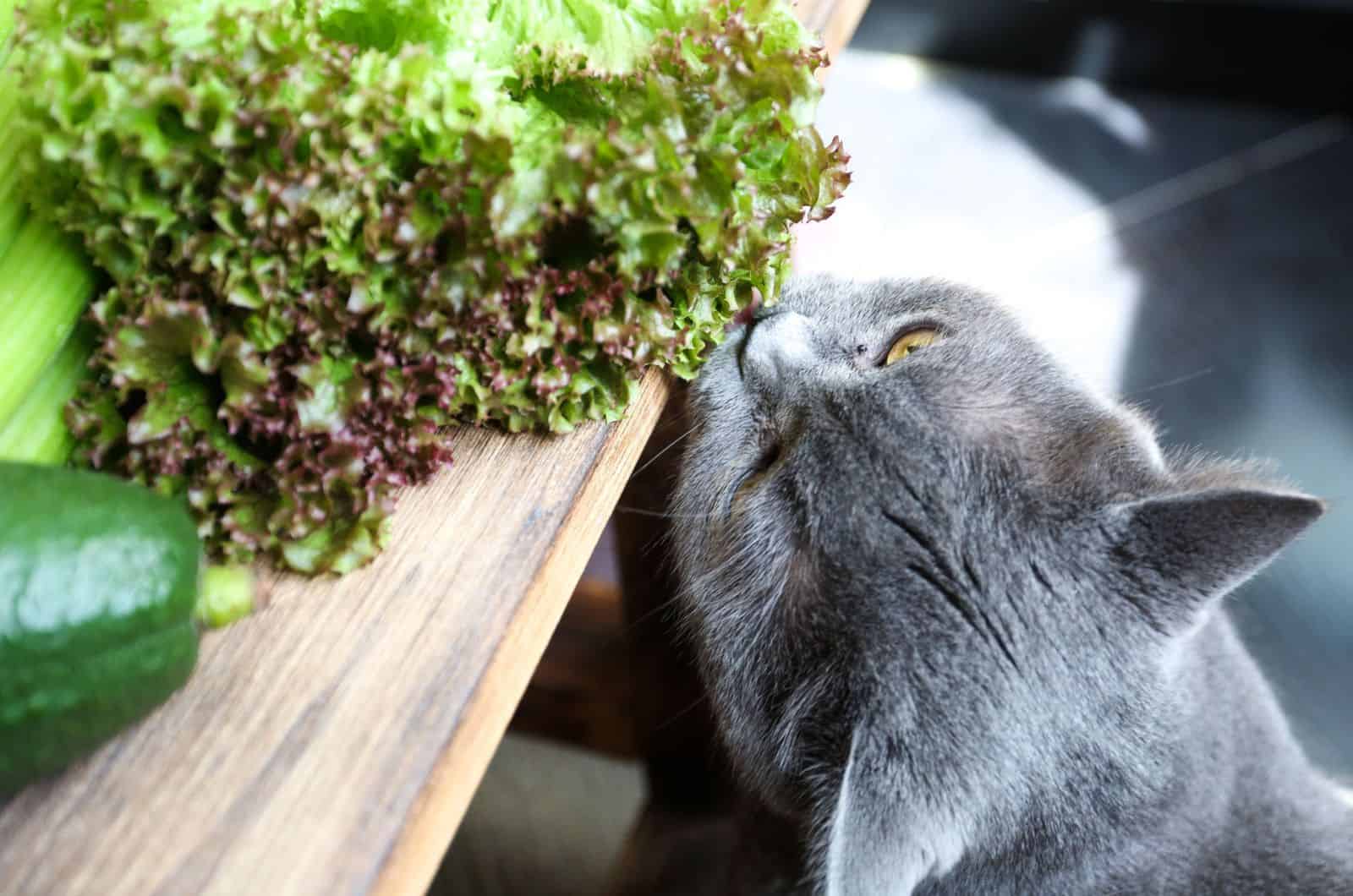
Lettuce isn’t poisonous, as I said before, so it is safe to feed it to your cat. There are a few dietary and health benefits of cats eating lettuce.
Lettuce is full of vitamins (especially vitamin K and vitamin A), and it gives your cat calcium and folate. It is a low-calorie food with a high fiber content.
Vitamins C, A, and K, are good for cleansing; they serve as antioxidants to boost your cat’s immune system. Vitamin K, in particular, is a bone strengthener, working along with calcium. It is also good for the prevention of blood clots in cats.
Calcium keeps a cat’s bones and teeth healthy and strong, but it also prevents blood clotting and helps maintain nerve function. Folate helps in the cat’s DNA and gene production, while potassium lowers the blood pressure and reduces any damage that salt does to the cat’s body.
Lettuce is also very good for hydration. Lettuce has high water content so it is a great addition to your cat’s diet if your cat isn’t much of a water drinker. However, you should still keep an eye on your cat and make sure it drinks water as well. Lettuce isn’t a substitute for water, but it can be a useful addition to a cat’s diet.
These are some basic health benefits. However, there are 5 other reasons why lettuce is good for cats, so read on to find out more!
1. Adds A Variety Of Flavors
Cats, like people, love to have a variety of flavors and different options of food offered. Adding lettuce to your cat’s diet, whether as a snack or as an addition to your cat’s food, will keep them stimulated and prevent them from getting bored with their diet.
2. Prevents Weight Gain
Next to keeping your cat hydrated, lettuce can help keep your cat maintain a healthy weight. Perhaps you have some trouble with your foodie cat’s tendency to gain weight? Lettuce is a low-calorie snack that won’t contribute to weight gain and can help with weight management.
3. Helps Cat’s Digestive System
Lettuce has very high fiber content, so if you feed lettuce to your cat, it can help your furry friend with digesting its food. The fiber that your cat gets from lettuce will help your cat to produce healthy bowel movements so your cat will poop everything out smoothly and without trouble. If your cat is suffering from constipation, consider feeding lettuce to increase dietary fiber in the daily diet.
However, iceberg lettuce isn’t ideal for digestion; it may make things worse. Iceberg lettuce can cause diarrhea in cats as it makes everything a bit too smooth, i.e. it makes your cat’s stool runny, so it’s best to avoid this type of lettuce. We don’t want constipation, but we don’t want diarrhea either!
Related: Cat Poop Half Firm Half Soft: 5 Reasons And How To Help
4. Nutritional Values
Lettuce is full of vitamins and nutrients which are beneficial for your cat’s health. All these additional nutritional values can only be good for your cat; they are not essential as most of your cat’s nutrition should come from meat sources of protein, but additional nutrition certainly won’t do any harm.
Fun fact: There is another vegetable packed with vitamins – spinach. If you want to learn more about it, read an article on can cats eat spinach.
5. Lettuce Saves Other Plants
Many cats have a funny habit of munching on our flowers, and many of them love to nibble on our house plants. Feeding lettuce to your cat can save your other beautiful plants from being bitten. If your cat has its own green vegetable (i.e. lettuce) to eat, it won’t need to go looking for other leafy greens to munch on.
If your kitty is particularly prone to munching on flowers, you might find this article about the effects of baby’s breath plant on cats particularly interesting.
How To Safely Feed Lettuce To Your Cat
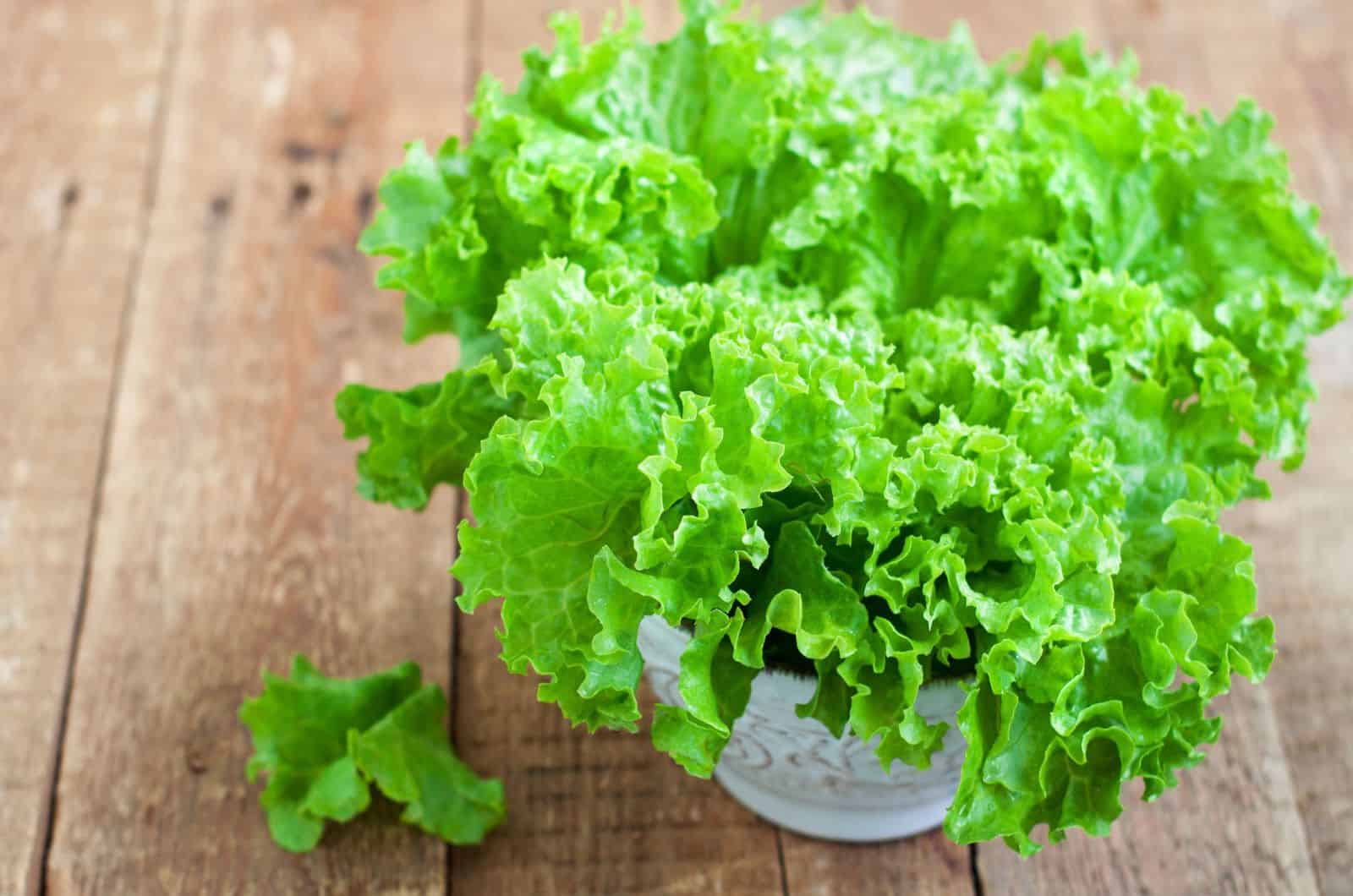
Before you head to the fridge to make your cat a salad, remember that cats are obligate carnivores, and they require their primary source of food to be meat-based. Cats require protein, and lettuce isn’t enough as a whole meal, only as a supplement.
If your cat shows an interest in eating lettuce, you can feed it some. First, make sure the lettuce is fresh and clean (you don’t want any harmful pesticides or residues to be left on it), and then give your cat lettuce using the advice below.
1. Cut The Lettuce Into Small Pieces
You should only ever feed your cat small chunks of any veggie you want it to try, (as long as the veggie itself is safe). You can slice these green leaf veggies into thin vertical slices that resemble grass, or chop it up into smaller chunks. If your cat rejects the lettuce the first time you offer it, it might accept it the next time if given in a different shape.
2. Try Different Types
There are different types of lettuce and while iceberg lettuce should be avoided, there are plenty of other types you can try.
• Butter lettuce – this type of lettuce is full of vitamins and minerals, and is good and safe for cats, as long as you feed it in small amounts.
• Green leaf lettuce – this type is more nutritious than iceberg lettuce, but it has lower water content. However, this type of lettuce is safe for cats and it provides the cat with vitamins and dietary fiber, calcium and folate, all without adding excess calories.
• Romaine lettuce – the romaine variety of lettuce has a high mineral content. It is full of phosphorus, potassium, and magnesium, but it has a relatively low fiber content. This variety is also safe when given in small amounts.
3. Add Lettuce Into Cat Food
Some cats might not want to try lettuce, it might look weird or unappealing to your cat. You can trick your cat by putting the lettuce into cat food or some other meaty meal you feed your cat. Covering lettuce with sauce and meat chunks or mixing small pieces of lettuce with cat food can do the trick.
4. Offer Your Cat Lettuce Again & Again
If your cat likes lettuce, you won’t have to do this, but perhaps you want your cat to eat some lettuce; maybe it isn’t drinking enough water, and you want to add lettuce as a good water source. If your cat simply refuses the lettuce, you should be patient, and don’t give up right away.
Offer lettuce to your cat many times and cut it into different shapes. Your cat will eventually think that you’re offering something good, and it will try it.
Precautions When Feeding Lettuce To Cats
It is acceptable to feed lettuce to your cat; however, it is not advised to feed your cat only lettuce. Cats are carnivores, which means they need meat to survive. They absolutely cannot get all of the nutrients, minerals, proteins, vitamins, etc., that they require from plant-based foods.
Cats do not need a lot of lettuce to get the benefits from it. A small leaf chopped into pieces and presented to your cat, maybe once a week, is perfectly ok.
As we have already discussed, iceberg lettuce is best avoided and other varieties of lettuce should be given in small amounts and given with other foods.
Suggested Read: Can Cats Eat Celery? Here’s What You NEED To Know!
Cats And Leafy Greens

Additionally, you might be interested to know which green and leafy vegetables are safe for your feline friend, and which aren’t?
Cats, like dogs and many other animals, like to eat grass, and most pet owners will be aware of this behavior. Grass is a leafy green that cats love and sometimes even need. Grass is full of folic acid, and it provides digestive enzymes which help cats digest their food, especially if something is hard to process.
Cats sometimes throw up after eating grass, which is generally a good thing since it helps your cat get rid of something that couldn’t be properly digested. For example, hairballs. Your cat might be having some trouble with hairballs stuck in its throat or digestive system, and eating grass can help it to throw up and expel the hairball.
A healthy cat’s typical life expectancy should be 17 to 20 years when feeding appropriately. Cats live longer on a balanced food diet, rich in veggies and meat and with a healthy mix of both dry food and wet food. Cats are also keen on eating dark leafy greens, so let’s see what other human foods cats can eat.
1. Bok Choy
Bok Choy is a slightly bitter veggie, but the advantages of this delicious plant are numerous. If your cat wants to try it, go ahead and feed it.
2. Broccoli
Broccoli contains antioxidants, vitamin C, and bioflavonoids, all of which can help boost your cat’s immune system. Broccoli also contains fiber. When offering broccoli to your cat, avoid overcooking it (the more raw it is, the better) and avoid seasoning. Remember, seasonings might upset your cat’s stomach.
3. Kale
These leafy green veggies are high in vitamins and minerals that can benefit your cat. Kale is high in vitamin A and copper, both of which are essential nutrients. Bear in mind that vegetables should account for no more than 10% of your cat’s diet. Vegetables that have been lightly cooked and minced should be put in the cat’s food bowl with the meat-based food you feed your cat. It would take a special cat to eat the veggies individually!
4. Collard Greens
Collard greens, along with these other green vegetables, are a good source of fiber. To ensure optimal vitality and value to your cat, make sure the leaves are clean, fresh and green.
To prepare these veggies, mince them and then steam cook them for no longer than 50 seconds in order to soften them. This process softens the cell membranes of the veggie, allowing the nutrients in it to be released. Cooking eliminates the nutrients, so avoid exposing them to extreme heat so your cat can get the benefits.
5. Carrots
Carrots contain lycopene and are high in antioxidants which help prevent some cancers. They provide excellent protection against degenerative illnesses and cancer cell proliferation. Cancer affects one out of two dogs and one out of every five cats.
Lycopene also delays the development of age-related eyesight loss. Cats’ lenses can become foggy as they age, and lycopene can help prevent this. Remember, when preparing human food, in this case, carrots, for your cat, make them soft and small, or your cat probably won’t eat it and will therefore miss out on the many benefits they offer.
6. Green Beans
Green beans are neither poisonous nor harmful for cats. In fact, from a nutritional standpoint, they are abundant in fiber and contain quite a high quantity of protein for a vegetable.
Green beans are also frequently recommended for cats that are suffering from obesity so they may be helpful if you want your cat to lose weight. Green beans can be used as a healthy snack or as an addition to your cat’s normal food, if your veterinarian recommends it.
Check out more about: Can Cats Eat Beans?
7. Meat & Fish
A cat’s diet should be meat-based, so for all the cat foods you buy, always look for meat-based and grain-free.
Taurine is an amino acid that cats require, which they get through meat, be it hearts, tissue, and/or brains. Hearts, livers, kidneys, spleens, and a small amount of stomach or skin are all crucial organs that may be acquired from your local butcher. Simply mince the raw organs and flesh in a grinder at home, or have the butcher grind it for you.
Whereas a cat’s diet should consist of around 70% meat, no more than 15% of your cat’s food, or generally speaking once a week, should consist of fish. Fish contains omega-3 fatty acids, which make it extremely beneficial to cats. Feeding your cat flaxseed oil as a source of omega 3’s is less effective as cats lack the conversion mechanism to convert those specific omega compounds into the ones that work in their systems, so it’s best to stick with fish.
Giving your cat sardines, tuna, salmon and even crab meat is always a good option.
If you are concerned about germs or bacteria, one to two drops of grapefruit seed extract mixed with about 30 ml of water can be used to soak raw meat, animal organs, and fish.
8. Fruits: Apples, Plums, Peaches, Pears…
Though it’s best to avoid citrus fruits (most cats don’t like them), pears, apples, plums, and peaches are all acceptable treats and/or additions for your cat, again when given in moderation. Be aware that eating too many of these fruits might induce hyperactivity, so always give small portions.
See also: Can Cats Eat Dates? Everything You Need To Know
What Not To Feed Your Cat
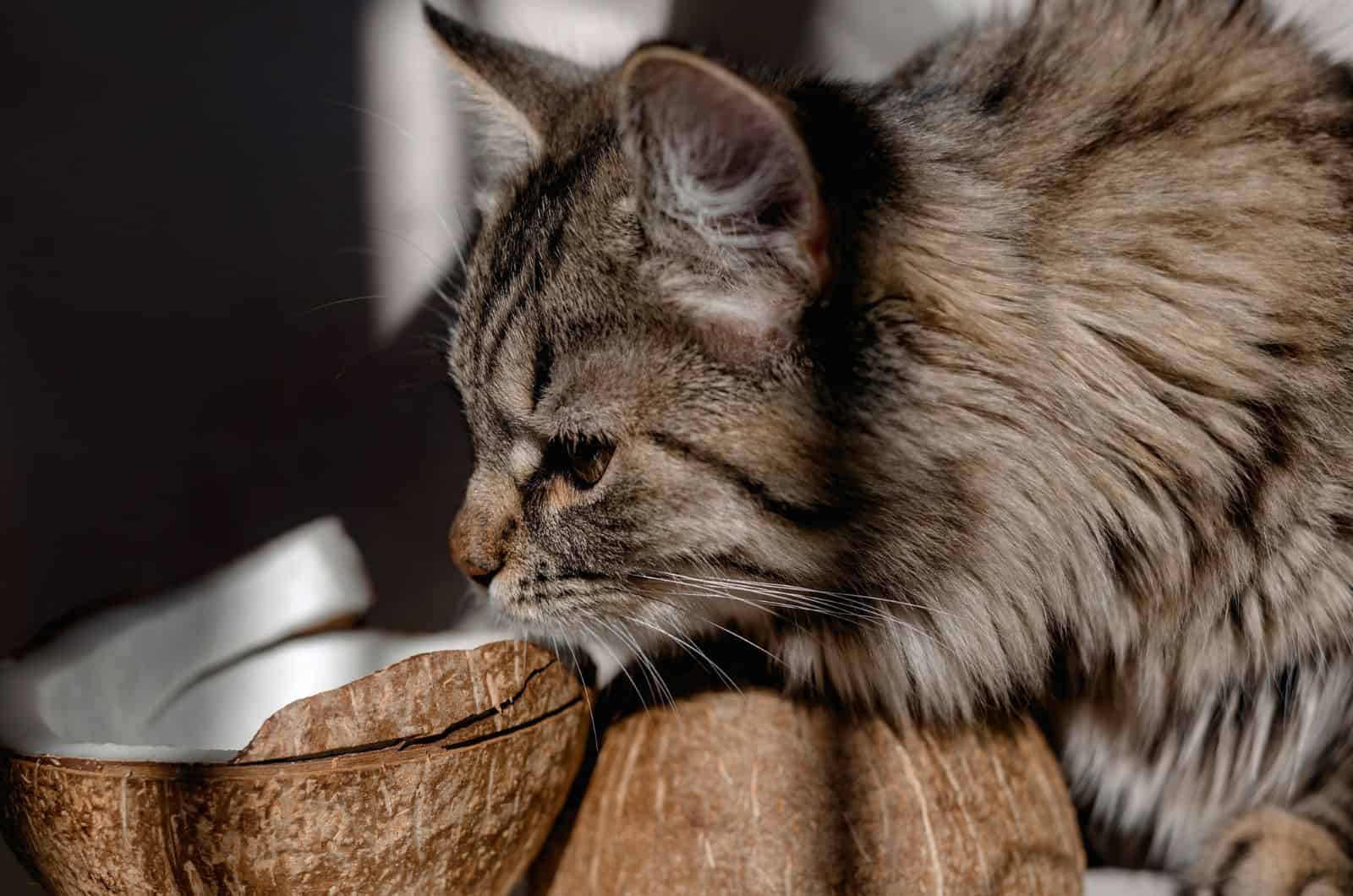
We’ve covered what your cats can eat from the human food options, but what is harmful or toxic? What veggies aren’t good for our beloved cats and should be avoided? Let’s find out.
The following are some of the most common human foods or food ingredients that people wonder whether or not they can be given to their cat.
1. Yeast
Bread dough with yeast can rise, causing gas to accumulate in your cat’s digestive tract. This might result in stomach bloating, which can be catastrophic. Furthermore, the yeast creates alcohol as a byproduct, which presents its own set of issues since alcohol should never be given to cats. However, a small amount of baked bread is deemed safe for cats that are generally healthy.
2. Chocolate
Chocolate includes methylxanthines which are poisonous to cats and can induce vomiting, diarrhea, seizures, and even death. The number of methylxanthines in different varieties of chocolate changes. White chocolate is the least harmful, while cocoa powder is the most fatal.
Keep in mind that, even though it’s okay to give your kitty a small treat such as a bite of a pancake once in a while, it definitely should contain no chocolate topping!
3. Citrus Fruits
Citrus fruits, such as lemons, limes, and oranges, contain citric acid and essential oils that can be harmful to cats and should be avoided.
While modest doses are likely to only induce a stomach ache, high amounts can cause vomiting, diarrhea, and problems in the cat’s central nervous system.
4. Coconut
Coconut milk and coconut chunks can cause intestinal problems in cats; small amounts are unlikely to be fatal, but they should be avoided. Coconut water is too rich in potassium to be suitable for cats. However, coconut oil may assist with some cat skin problems. Consult your veterinarian before using coconut as a natural cure or adding it into your cat’s diet.
5. Dairy Products
Dairy items can cause digestive issues in cats as many cats can’t properly digest dairy (cheese, milk, yogurts). It is best to avoid them entirely, but you can ask your veterinarian (if your cat craves dairy) whether a lactose-free option is an appropriate treat.
See also: Do Cats Like Milk? Truth Or Myth?
6. Raisins & Nuts
While the specific reason why they are hazardous to pets is unknown, there is evidence that giving raisins to cats (and dogs) might result in renal failure. Macadamia nuts are also harmful to pets, and again, the specific mechanism of poisoning is unclear. Other nuts, like pecans, almonds, and walnuts, are high in oils and fat content, which can cause digestive discomfort and even pancreatitis in cats.
7. Raw Eggs
Salmonella bacteria can be found in raw eggs. Infection symptoms include vomiting, diarrhea, and fever. Avidin is also found in raw eggs. It is an enzyme that prevents cats from absorbing biotin, a vitamin that is essential for healthy skin and hair.
8. Raw Meat And Fish
Raw or undercooked meat, like raw eggs, can be infected with Salmonella and/or E. coli bacteria. Gastrointestinal symptoms (usually diarrhea) are common in pets that are fed raw meat-based diets. Raw fish, like raw meat and raw eggs, can also carry parasites and bacteria that can cause infection and food poisoning in cats.
9. Salt And Spices
Salt, like many other spices and condiments, is harmful to cats. Salt and salty meals in large quantities can induce vomiting, diarrhea, seizures, convulsions, and in some cases, even death.
To learn more about the effects of salt on cats, I suggest reading an article on can cats eat salt.
10. Some Herbs And Veggies
Though cats can eat some types of vegetables, like lettuce, bell peppers, etc.; leeks, shallots, onions, garlic, scallions, and chives are very dangerous to cats, causing gastrointestinal difficulties and even red blood cell destruction. Foods that contain these vegetables and herbs should also be avoided.
FAQ
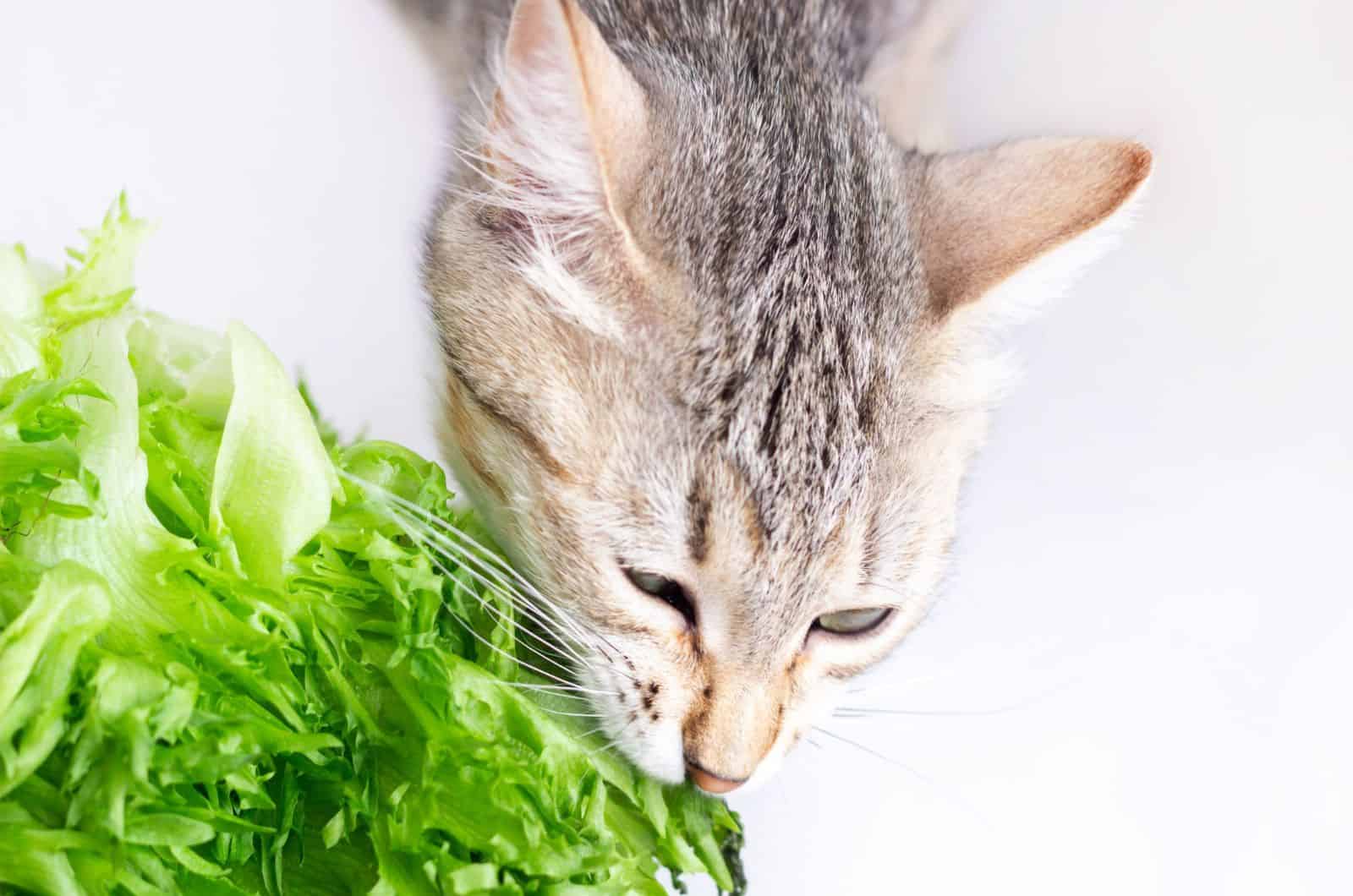
Is it OK for cats to eat iceberg lettuce?
No. Cats shouldn’t eat Iceberg lettuce; it can only cause health issues, most commonly diarrhea, which will contribute to your cat’s dehydration. If your cat likes lettuce, you should consider other types of lettuce for your cat’s diet. Lettuce should add to your cat’s hydration and not harm it.
What kind of lettuce can cats eat?
The best choice is dark and organic, there are different types of lettuce you can buy either at a local shop or on Amazon. You can try giving your cat butter lettuce, green leaf lettuce, or romaine lettuce. Whichever type of lettuce you choose, make sure it is fresh and clean before you feed it to the cat.
Which leafy vegetables can cats eat?
Green beans, carrots, collard greens, bok choy, broccoli, spinach, zucchini, and kale, are just a few of the most nutritious green leafy vegetables cats can eat.
Is lettuce good for cats?
Yes, lettuce isn’t toxic and is a good addition to your cat’s diet. You can consider including it as a snack or adding it to your cat’s usual meals, preferably once a week. Chop it up into small pieces and give a small amount to your cat to boost hydration and provide many vitamins, minerals, and nutrients for your cat’s health.
What are some healthy vegetables for cats to eat?
Some of the healthy vegetables that you can also give to your cat include lettuce, zucchini, broccoli, kale, spinach, carrots, and green beans.
What is the best way to feed cats lettuce?
The best way to include lettuce in your cat’s diet is to give it as a snack or treat or to add it to the cat’s usual meal. Lettuce should never be a whole meal, but it can be given as additional food. You should always check the lettuce is fresh and clean before you give it to your cat. Chop it up into small pieces and feed it to your cat; you may need to mix it in with your cat’s usual food
Can cats eat cabbage?
Yes. You can give cabbage to your cat, but only in small quantities! You should shred the cabbage and cook it before feeding it to your cat since raw cabbage is hard for them to chew on. Remember not to give too much, you should only give 6 to 9 grams of the cooked cabbage, one serving in seven days. Cabbage helps your cat’s digestion, and it’s good for fur and skin.
However, if your cat’s not keen on cabbage, you can leave it off the menu. Cabbage is full of thiocyanate, which can mess with the cat’s thyroid gland (but only if your cat eats a lot of cabbage for an extended period of time). This is also why you should cook cabbage, as it lowers the thiocyanate levels.
What are the benefits of cats eating lettuce?
Lettuce is full of vitamins A, C, and K. It also gives your cat calcium and folate. It has low-calorie count and high fiber content which is good for your cat’s digestion. It also has a high water content which helps keep your cat hydrated.
Final Words
Every cat owner wonders from time to time what human food they can feed to their cats, which is how we got to wondering, can cats eat lettuce?
In short, yes, they can! Lettuce is not harmful or dangerous to cats, so you may give it to them safely. However, before making any changes to your cat’s nutrition, you should contact your veterinarian and proceed slowly.
Lettuce contains vitamins A, C, and K, as well as calcium and folate. It is low-calorie and has a high fiber level, which is beneficial to your cat’s digestive system. It also contains a lot of water, which helps to keep your cat hydrated. The only precaution you should keep in mind is the type and amount of lettuce you give.
It is fine to feed your cat lettuce, but it is not recommended to feed your cat exclusively lettuce. Cats are obligate carnivores, which means they must consume meat in order to thrive. They simply cannot obtain all of the nutrients, minerals, proteins, and vitamins that they require from plant-based meals alone. Cats do not require a large amount of lettuce to benefit from it. A single, little leaf cut into pieces and fed to your cat once a week is perfect.
As I’ve said, iceberg lettuce should be avoided, and other types of lettuce, such as romaine, green leaf, or butter lettuce, should be given in limited amounts and mixed in with other meals. Hopefully, I’ve answered all your questions about cats and lettuce, and you now know how and when to feed it to your cat.

